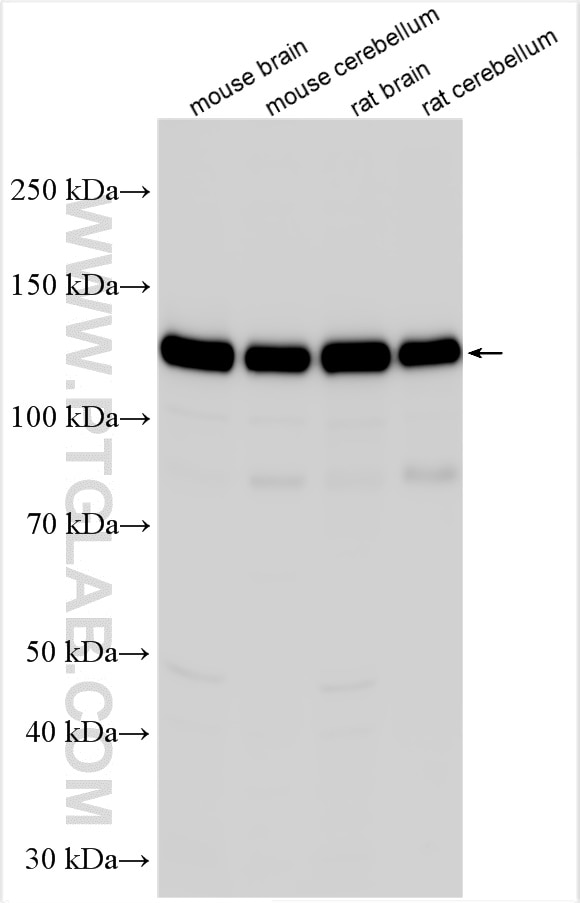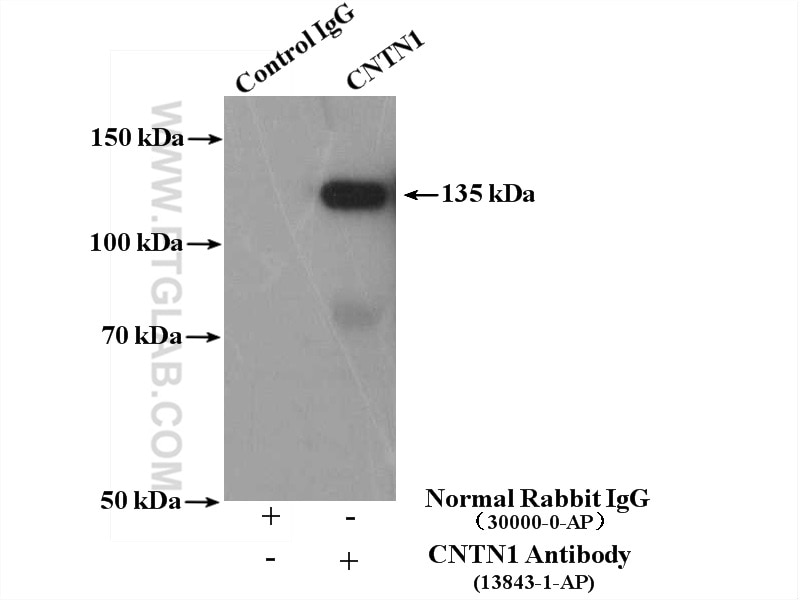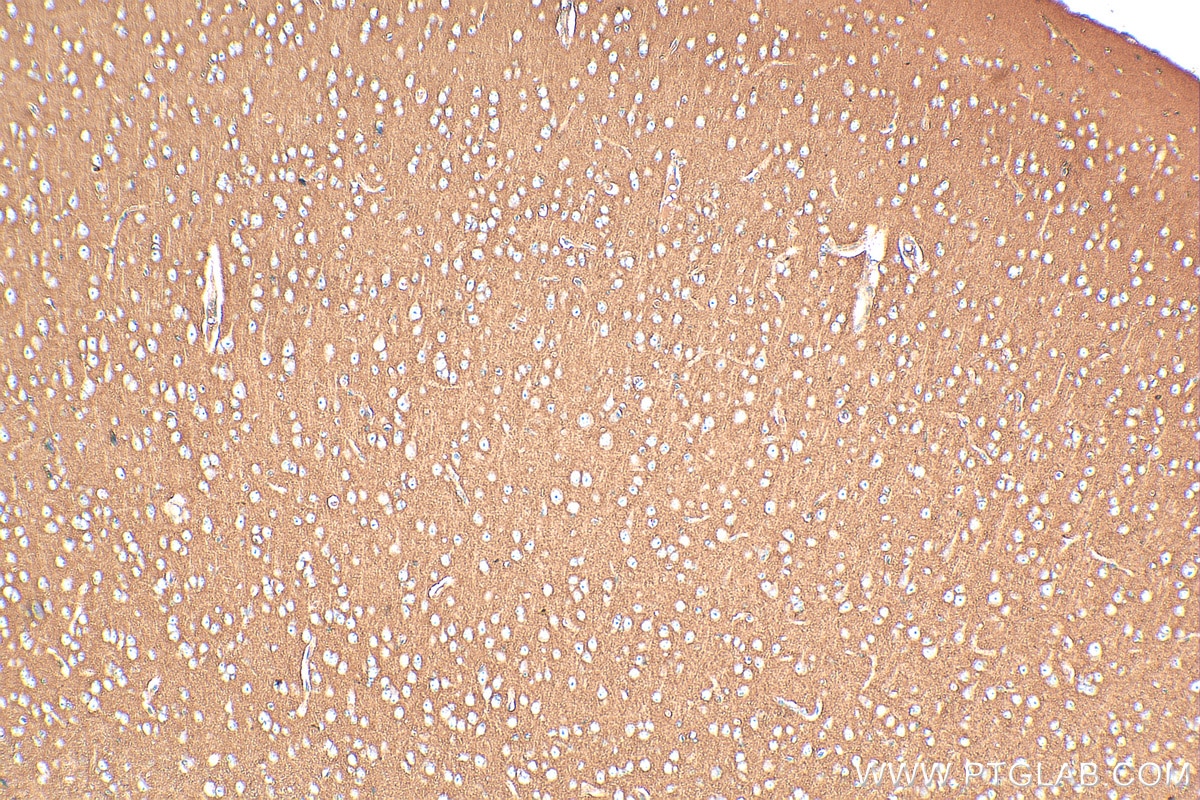- Phare
- Validé par KD/KO
Anticorps Polyclonal de lapin anti-CNTN1
CNTN1 Polyclonal Antibody for WB, IP, IHC, ELISA
Hôte / Isotype
Lapin / IgG
Réactivité testée
Humain, rat, souris
Applications
WB, IHC, IF, IP, ELISA
Conjugaison
Non conjugué
N° de cat : 13843-1-AP
Synonymes
Galerie de données de validation
Applications testées
| Résultats positifs en WB | tissu cérébral de souris, tissu cérébral de rat, tissu de cervelet de rat, tissu de cervelet de souris |
| Résultats positifs en IP | tissu cérébral de rat |
| Résultats positifs en IHC | tissu cérébral de souris, il est suggéré de démasquer l'antigène avec un tampon de TE buffer pH 9.0; (*) À défaut, 'le démasquage de l'antigène peut être 'effectué avec un tampon citrate pH 6,0. |
Dilution recommandée
| Application | Dilution |
|---|---|
| Western Blot (WB) | WB : 1:5000-1:50000 |
| Immunoprécipitation (IP) | IP : 0.5-4.0 ug for 1.0-3.0 mg of total protein lysate |
| Immunohistochimie (IHC) | IHC : 1:200-1:800 |
| It is recommended that this reagent should be titrated in each testing system to obtain optimal results. | |
| Sample-dependent, check data in validation data gallery | |
Applications publiées
| KD/KO | See 2 publications below |
| WB | See 8 publications below |
| IHC | See 3 publications below |
| IF | See 2 publications below |
Informations sur le produit
13843-1-AP cible CNTN1 dans les applications de WB, IHC, IF, IP, ELISA et montre une réactivité avec des échantillons Humain, rat, souris
| Réactivité | Humain, rat, souris |
| Réactivité citée | rat, Humain, souris |
| Hôte / Isotype | Lapin / IgG |
| Clonalité | Polyclonal |
| Type | Anticorps |
| Immunogène | CNTN1 Protéine recombinante Ag4803 |
| Nom complet | contactin 1 |
| Masse moléculaire calculée | 1018 aa, 113 kDa |
| Poids moléculaire observé | 135 kDa |
| Numéro d’acquisition GenBank | BC036569 |
| Symbole du gène | CNTN1 |
| Identification du gène (NCBI) | 1272 |
| Conjugaison | Non conjugué |
| Forme | Liquide |
| Méthode de purification | Purification par affinité contre l'antigène |
| Tampon de stockage | PBS with 0.02% sodium azide and 50% glycerol |
| Conditions de stockage | Stocker à -20°C. Stable pendant un an après l'expédition. L'aliquotage n'est pas nécessaire pour le stockage à -20oC Les 20ul contiennent 0,1% de BSA. |
Informations générales
Contactin-1 (CNTN1), also known as Glycoprotein gp135 or Neural cell surface protein F3, is a neuronal cell adhesion molecule of the immunoglobulin superfamily (PMID: 3049624). It consists of six Ig domains, four fibronectin-like motifs, and a glycosylphosphatidylinositol (GPI)-moiety. Expressed by the central and peripheral neurons, CNTN1 contributes to the formation and function of neuronal connections. It plays a role in axon extension and formation of septate-like junctions between axons and myelinating glial cells (PMID: 23724143). In addition, acting as a ligand for Notch, CNTN1 initiates a NOTCH/DTX1 signaling pathway that promotes oligodendrocyte maturation and myelination (PMID: 14567914).
Protocole
| Product Specific Protocols | |
|---|---|
| WB protocol for CNTN1 antibody 13843-1-AP | Download protocol |
| IHC protocol for CNTN1 antibody 13843-1-AP | Download protocol |
| IP protocol for CNTN1 antibody 13843-1-AP | Download protocol |
| Standard Protocols | |
|---|---|
| Click here to view our Standard Protocols |
Publications
| Species | Application | Title |
|---|---|---|
Nat Commun Identification of genes associated with cortical malformation using a transposon-mediated somatic mutagenesis screen in mice.
| ||
Nat Commun Spatial mapping of juxtacrine axo-glial interactions identifies novel molecules in peripheral myelination. | ||
Front Mol Neurosci Contactin-1/F3 Regulates Neuronal Migration and Morphogenesis Through Modulating RhoA Activity.
| ||
Front Genet CNTN-1 Upregulation Induced by Low-Dose Cisplatin Promotes Malignant Progression of Lung Adenocarcinoma Cells via Activation of Epithelial-Mesenchymal Transition. | ||
Arch Med Sci CNTN-1 promotes docetaxel resistance and epithelial-to-mesenchymal transition via the PI3K/Akt signaling pathway in prostate cancer. |





